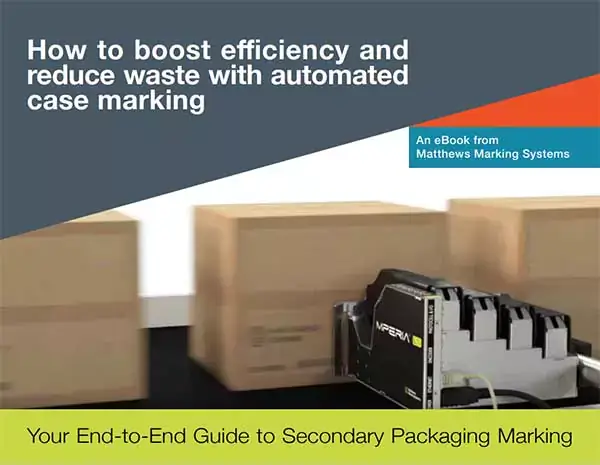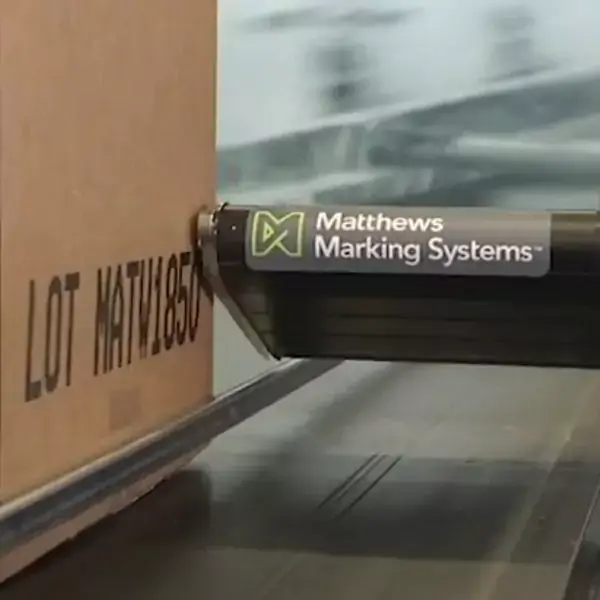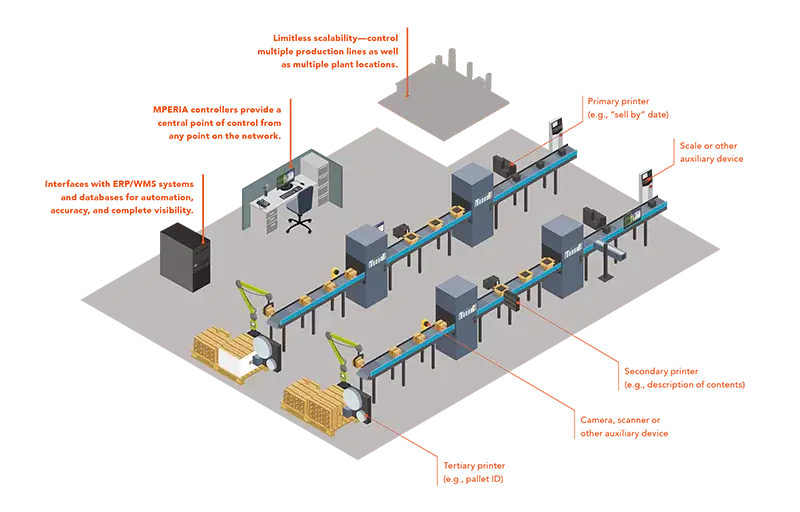5 Crucial Questions to Ask When Upgrading Your Carton Marking System

Executive Summary: It’s important to periodically evaluate your approach to marking and coding. Research shows that unplanned outages can cost a manufacturing company as much as $260,000 an hour. The search for reliability often leads to drop-on-demand (DOD) valve marking systems such as the V-Series from Matthews Marking Systems.
More and more consumer-packaged goods manufacturers are taking advantage of the significant cost savings and superior flexibility they can realize by printing directly on secondary packaging such as corrugated cartons and cases of packaged products. Virtually all secondary packaging requires some form of marking, ranging from brand logos and graphics through to batch codes or large human readable text visible to a picker or forklift driver.
In a perfect world, most packagers hope their marking solutions are a “set it and forget it” proposition with the right marks “automagically” appearing on the right products, cases and cartons time after time. In the real world, however, production lines and packaging shapes and sizes are constantly changing and evolving.
To keep pace, it’s important to periodically evaluate your approach to marking and coding and explore whether the latest technologies can help you improve efficiency, reduce or eliminate marking-related line stoppages or accommodate new packaging substrates and requirements. When the time comes to invest in a carton marking solution to support a new initiative or because it’s time to upgrade old equipment, here are five questions you should be asking to help inform your decision making.

For a deeper dive, download our end-to-end guide to carton marking.
1. How critical is reliable, trouble-free marking and coding to my production efficiency?
If reliability isn’t at the top of your list, it should be, particularly in light of research showing that unplanned outages can cost a manufacturing company as much as $260,000 an hour. Production efficiency and uptime is only as good as your weakest link, and you want to avoid having that weak link be your marking solution. One way to forestall unplanned downtime and boost efficiency is to replace aging marking and coding equipment before it fails. Waiting for it to act up may be too late – and drastically impact your bottom line.
For many packagers and producers, the search for reliability often leads to valve marking systems such as the V-Series from Matthews Marking Systems to print lot codes, batch codes, large human-readable marks, and other alphanumeric traceability codes. Our DOD inkjet printers are well-established as the fastest and most reliable in industry, lasting for over 9 billion cycles before needing tuning. A built-in flushing valve system means that periodic cleaning and maintenance are a breeze. The low maintenance and high reliability DOD technology delivers are constants regardless of the ink type used, including pigmented inks that often can cause clogging issues for other technologies.
Reliable operation also means that you don’t have to worry about running out of ink in the middle of production runs. This is where Matthews’ DOD printers again rise to the top with a range of bulk ink supply options ranging from 1-2 liter jugs all the way up to 275-gallon totes for use with water-based inks. Such bulk supply options reliably deliver inks and cleaners ensuring optimized performance when you need it most.
2. Can the solution easily integrate without custom software and adapt to my production line?
As we saw at the recent Pack Expo in Chicago, new packaging innovations are coming to market that improve sustainability or more easily enable shelf ready packaging (SRP). At the same time, advancements in robotics and packaging systems may provide opportunities to cope with labor shortages, lower costs and improve output. To take advantage of these advancements, it’s imperative that your marking and coding system doesn’t hold you back from adopting new tech.
To that end, your marking and coding system should have flexibility as it’s middle name. The system should offer the ability to adapt to your production needs, not the other way around. DOD printers from Matthews offer multiple combinations of valves and nozzle options so they’re adaptable to your needs. A massive ink catalog (over 800 inks) allows virtually any substrate to be accommodated. Printheads can be mounted where they’re needed — over, under, or beside your production line.
Similarly, your print controller should be able to integrate with your existing systems – and new ones as they are implemented – without the need for additional hardware or specialized middleware. From that standpoint, Matthews’ MPERIA platform is the perfect fit with DOD as well virtually any other print and labeling system. It uses your existing network infrastructure and the netFolder feature to synchronize layouts and variable data with your marking technologies and enterprise systems, providing maximum flexibility and adaptability.
3. Is the solution fast and robust enough to take the punishment my production dishes out?
Most facilities with boxes, people and machinery churning away at high speeds are bound to accumulate printhead-clogging dust and debris. Many are far worse. No doubt, you’ve invested in conveyor and packaging equipment that can take a beating and withstand wash downs and other abuse day in and day out. It only makes sense to invest in marking and coding equipment that at least matches the durability of your operation overall.
For relatively clean, climate-controlled operations that also need high-resolution marks for barcodes or branding, thermal inkjet (TIJ) and piezo inkjet (PIJ) printers such as the Matthews L-Series and T-Series designed for secondary packaging applications can work well. And if labeling is required, there’s our A-Series automatic print and apply labelers. But for tougher environments – think dust, dirt, moisture and more – you’ll want to explore valve jet DOD printer technology.

The MPERIA V-Series DOD printer is one of the industry’s most reliable solutions for printing lot codes, batch codes, large human-readable marks, and other alphanumeric and 2D traceability codes on cases and cartons.
What makes DOD ideal for dusty, dirty environments? Some technologies like continuous inkjet (CIJ) printers, often used for primary package coding, have a steady flow of exposed ink that can get contaminated during normal operations. This can lead to line stoppages and degraded print quality. The valves in a DOD printer, on the other hand, only open long enough to fire out a drop of ink and then seal completely. This prevents ink contamination and ensures quality marks time after time. That’s why DOD print technology has become the global standard for use in industrial environments such as steel and lumber mills.
4. Am I ready for my next growth phase?
Preparing for rapid growth is a great problem to have – as long as your marking and coding solution can scale up as you add new lines and equipment or build out new facilities. Most printer controllers are limited to a few printheads, usually of the same type and from the same vendor who sold you the printers. Talk about limited scalability.
If growth is on the horizon, you’ll want to look for a printer control and integration platform with an open, high-performance architecture. This will allow you to integrate multiple types of print technologies, including third-party equipment, and ensure system redundancy with backup print equipment that can be automatically activated on your production line when needed.
Designed to grow with you, the Matthews MPERIA platform features a high-performance architecture that supports multiple print heads, including different technologies and print and apply labelers, from a single controller and can handle up to 900 unique codes per second. This means you can add additional marking equipment to your existing lines or expand to multiple plant locations with full integration across the entire operation.
Additionally, the V-Series DOD printhead supports expansion into new areas with its ability to mark porous and non-porous substrates, including paper, coated and uncoated corrugated fiberboard, and corrugated plastic as well as trays and shrink wrap. Character print output ranges from 3 to 127 millimeters (0.125 to 5 inches) and can be expanded by grouping multiple printheads to produce very large, stitched images. So, if growth includes more than just plant expansion, but larger or smaller marks as well, you’ll be prepared.
5. Can the system operate from a central location and automate message and code changeovers?
Costly errors and embarrassing mistakes in marking and coding often happen when there are too many cooks in the marking and coding kitchen. In this context, the unsavory mess results when primary, secondary and tertiary coding processes are separated from each other. With the exact opposite of seamless integration in place, coding “accuracy” requires that multiple operators communicate effectively so they can deal with complex message changeovers taking place in real-time. No wonder mistakes happen.
To avoid such scenarios, you’ll want to take an end-to-end approach to marking and coding so that you have full oversight of what’s being placed on products, cartons and pallets across all phases of production. Think of having a master chef creating a masterpiece as opposed to many cooks randomly tossing in ingredients. Going a step further, by integrating with back-end systems you can automate message creation and quickly and easily adapt to customer changes and regulatory requirements.
For many mid-size and large operations, the mastermind controlling marking and coding at every stage of their packaging and carton marking operation is MPERIA. As shown in the graphic below, MPERIA provides a central point of control from anywhere in the network. And line operators only need to be trained on a single system to start jobs, manage changeovers, and quickly resolve issues.

Carton coding solutions from a supplier you can count on
Matthews Marking Systems is a global supplier of printing systems and inks for product identification, branding, operational marking, and regulatory compliance. With more than 170 years of marking and coding experience, we’ve established a global reputation as a premier innovator and manufacturer in the marking and coding industry. If you’re looking for the right solution for your carton coding needs from a supplier you can trust to be there year after year, we’re here to help. Give us a call at 800.775.7775 or email us at [email protected]. Learn more about marking systems on our case printing and labeling page.
